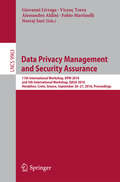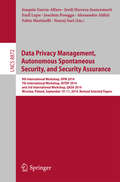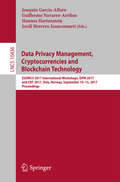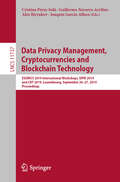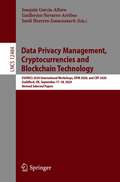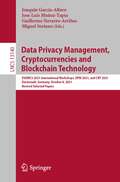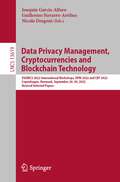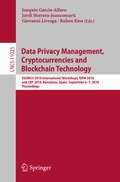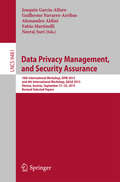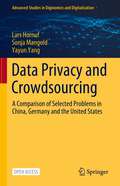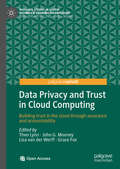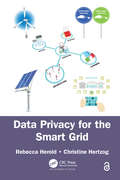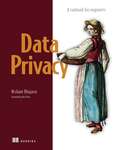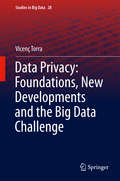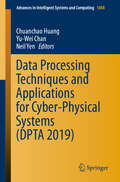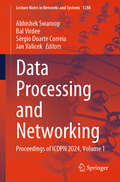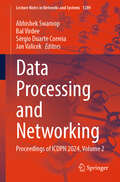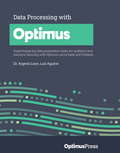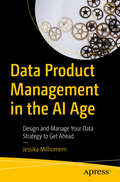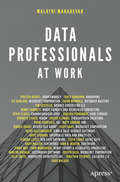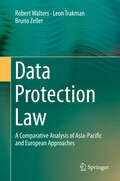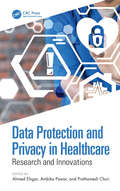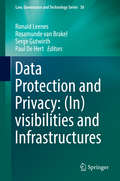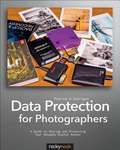- Table View
- List View
Data Privacy Management and Security Assurance: 11th International Workshop, DPM 2016 and 5th International Workshop, QASA 2016, Heraklion, Crete, Greece, September 26-27, 2016, Proceedings (Lecture Notes in Computer Science #9963)
by Alessandro Aldini Fabio Martinelli Neeraj Suri Vicenç Torra Giovanni LivragaThis book constitutes the refereed proceedings of the 11th International Workshop on Data Privacy Management, DPM 2016 and the 5th International Workshop on Quantitative Aspects in Security Assurance, QASA 2016, held in Heraklion, Crete, Greece, in September 2016. 9 full papers and 4 short papers out of 24 submissions are included in the DPM 2016 Workshop. They are organized around areas related to the management of privacy-sensitive informations, such as translation of high-level business goals into system-level privacy policies; administration of sensitive identifiers; data integration and privacy engineering. The QASA workshop centeres around research topics with a particular emphasis on the techniques for service oriented architectures, including aspects of dependability, privacy, risk and trust. Three full papers and one short papers out of 8 submissions are included in QASA 2016.
Data Privacy Management, Autonomous Spontaneous Security, and Security Assurance: 9th International Workshop, DPM 2014, 7th International Workshop, SETOP 2014, and 3rd International Workshop, QASA 2014, Wroclaw, Poland, September 10-11, 2014. Revised Selected Papers (Lecture Notes in Computer Science #8872)
by Alessandro Aldini Fabio Martinelli Joaquin Garcia-Alfaro Neeraj Suri Jordi Herrera-Joancomartí Emil Lupu Joachim PoseggaThis book constitutes the revised selected papers of the 9th International Workshop on Data Privacy Management, DPM 2014, the 7th International Workshop on Autonomous and Spontaneous Security, SETOP 2014, and the 3rd International Workshop on Quantitative Aspects in Security Assurance, held in Wroclaw, Poland, in September 2014, co-located with the 19th European Symposium on Research in Computer Security (ESORICS 2014). The volume contains 7 full and 4 short papers plus 1 keynote talk from the DPM workshop; 2 full papers and 1 keynote talk from the SETOP workshop; and 7 full papers and 1 keynote talk from the QASA workshop - selected out of 52 submissions. The papers are organized in topical sections on data privacy management; autonomous and spontaneous security; and quantitative aspects in security assurance.
Data Privacy Management, Cryptocurrencies and Blockchain Technology: ESORICS 2017 International Workshops, DPM 2017 and CBT 2017, Oslo, Norway, September 14-15, 2017, Proceedings (Lecture Notes in Computer Science #10436)
by Joaquin Garcia-Alfaro Guillermo Navarro-Arribas Jordi Herrera-Joancomartí Hannes HartensteinThis book constitutes the refereed conference proceedings of the 12th International Workshop on Data Privacy Management, DPM 2017, on conjunction with the 22nd European Symposium on Research in computer Security, ESORICS 2017 and the First International Workshop on Cryprocurrencies and Blockchain Technology (CBT 2017) held in Oslo, Norway, in September 2017. The DPM Workshop received 51 submissions from which 16 full papers were selected for presentation. The papers focus on challenging problems such as translation of high-level buiness goals into system level privacy policies, administration of sensitive identifiers, data integration and privacy engineering. From the CBT Workshop six full papers and four short papers out of 27 submissions are included. The selected papers cover aspects of identity management, smart contracts, soft- and hardforks, proof-of-works and proof of stake as well as on network layer aspects and the application of blockchain technology for secure connect event ticketing.
Data Privacy Management, Cryptocurrencies and Blockchain Technology: ESORICS 2019 International Workshops, DPM 2019 and CBT 2019, Luxembourg, September 26–27, 2019, Proceedings (Lecture Notes in Computer Science #11737)
by Joaquin Garcia-Alfaro Guillermo Navarro-Arribas Alex Biryukov Cristina Pérez-SolàThis book constitutes the refereed conference proceedings of the 14th International Workshop on Data Privacy Management, DPM 2019, and the Third International Workshop on Cryptocurrencies and Blockchain Technology, CBT 2019, held in conjunction with the 24th European Symposium on Research in Computer Security, ESORICS 2019, held in Luxembourg in September 2019. For the CBT Workshop 10 full and 8 short papers were accepted out of 39 submissions. The selected papers are organized in the following topical headings: lightning networks and level 2; smart contracts and applications; and payment systems, privacy and mining. The DPM Workshop received 26 submissions from which 8 full and 2 short papers were selected for presentation. The papers focus on privacy preserving data analysis; field/lab studies; and privacy by design and data anonymization.Chapter 2, “Integral Privacy Compliant Statistics Computation,” and Chapter 8, “Graph Perturbation as Noise Graph Addition: a New Perspective for Graph Anonymization,” of this book are available open access under a CC BY 4.0 license at link.springer.com.
Data Privacy Management, Cryptocurrencies and Blockchain Technology: ESORICS 2020 International Workshops, DPM 2020 and CBT 2020, Guildford, UK, September 17–18, 2020, Revised Selected Papers (Lecture Notes in Computer Science #12484)
by Joaquin Garcia-Alfaro Guillermo Navarro-Arribas Jordi Herrera-JoancomartiThis book constitutes the revised selected post conference proceedings of the 15th International Workshop on Data Privacy Management, DPM 2020, and the 4th International Workshop on Cryptocurrencies and Blockchain Technology, CBT 2020, held in conjunction with the 25th European Symposium on Research in Computer Security, ESORICS 2020, held in Guildford, UK in September 2020.For the CBT Workshop 8 full and 4 short papers were accepted out of 24 submissions. The selected papers are organized in the following topical headings: Transactions, Mining, Second Layer and Inter-bank Payments. The DPM Workshop received 38 submissions from which 12 full and 5 short papers were selected for presentation. The papers focus on Second Layer, Signature Schemes, Formal Methods, Privacy, SNARKs and Anonymity.
Data Privacy Management, Cryptocurrencies and Blockchain Technology: ESORICS 2021 International Workshops, DPM 2021 and CBT 2021, Darmstadt, Germany, October 8, 2021, Revised Selected Papers (Lecture Notes in Computer Science #13140)
by Joaquin Garcia-Alfaro Guillermo Navarro-Arribas Miguel Soriano Jose Luis Muñoz-TapiaThis book constitutes the refereed proceedings and revised selected papers from the 16th International Workshop on Data Privacy Management, DPM 2021, and the 5th International Workshop on Cryptocurrencies and Blockchain Technology, CBT 2021, which were held online on October 8, 2021, in conjunction with ESORICS 2021. The workshops were initially planned to take place in Darmstadt, Germany, and changed to an online event due to the COVID-19 pandemic.The DPM 2021 workshop received 25 submissions and accepted 7 full and 3 short papers for publication. These papers were organized in topical sections as follows: Risks and privacy preservation; policies and regulation; privacy and learning. For CBT 2021 6 full papers and 6 short papers were accepted out of 31 submissions. They were organized in topical sections as follows: Mining, consensus and market manipulation; smart contracts and anonymity.
Data Privacy Management, Cryptocurrencies and Blockchain Technology: ESORICS 2022 International Workshops, DPM 2022 and CBT 2022, Copenhagen, Denmark, September 26–30, 2022, Revised Selected Papers (Lecture Notes in Computer Science #13619)
by Joaquin Garcia-Alfaro Guillermo Navarro-Arribas Nicola DragoniThis book constitutes the refereed proceedings and revised selected papers from the ESORICS 2022 International Workshops on Data Privacy Management, Cryptocurrencies and Blockchain Technology, DPM 2022 and CBT 2022, which took place in Copenhagen, Denmark, during September 26–30, 2022.For DPM 2022, 10 full papers out of 21 submissions have been accepted for inclusion in this book. They were organized in topical sections as follows: differential privacy and data analysis; regulation, artificial intelligence, and formal verification; and leakage quantification and applications. The CBT 2022 workshop accepted 7 full papers and 3 short papers from 18 submissions. The papers were organized in the following topical sections: Bitcoin, lightning network and scalability; and anonymity, fault tolerance and governance; and short papers.
Data Privacy Management, Cryptocurrencies and Blockchain Technology: Esorics 2018 International Workshops, Dpm 2018 And Cbt 2018, Barcelona, Spain, September 6-7, 2018, Proceedings (Lecture Notes in Computer Science #11025)
by Joaquin Garcia-Alfaro Jordi Herrera-Joancomartí Giovanni Livraga Ruben RiosThis book constitutes the refereed conference proceedings of the 2nd International Workshop on Cryprocurrencies and Blockchain Technology, CBT 2018, and the 13thInternational Workshop on Data Privacy Management, DPM 2018, on conjunction with the 23nd European Symposium on Research in Computer Security, ESORICS 2018, held in Barcelona, Spain, in September 2018. From the CBT Workshop 7 full and 8 short papers out of 39 submissions are included. The selected papers cover aspects of identity management, smart contracts, soft- and hardforks, proof-of-works and proof of stake as well as on network layer aspects and the application of blockchain technology for secure connect event ticketing. The DPM Workshop received 36 submissions from which 11 full and 5 short papers were selected for presentation. The papers focus on challenging problems such as translation of high-level buiness goals into system level privacy policies, administration of sensitive identifiers, data integration and privacy engineering.
Data Privacy Management, and Security Assurance: 10th International Workshop, DPM 2015, and 4th International Workshop, QASA 2015, Vienna, Austria, September 21-22, 2015. Revised Selected Papers (Lecture Notes in Computer Science #9481)
by Alessandro Aldini Fabio Martinelli Joaquin Garcia-Alfaro Guillermo Navarro-Arribas Neeraj SuriThis book constitutes the revised selected papers of the10th International Workshop on Data Privacy Management, DPM 2015, and the 4thInternational Workshop on Quantitative Aspects in Security Assurance, QASA2015, held in Vienna, Austria, in September 2015, co-located with the 20thEuropean Symposium on Research in Computer Security, ESORICS 2015. In the DPM 2015 workshop edition, 39 submissions werereceived. In the end, 8 full papers, accompanied by 6 short papers, 2 positionpapers and 1 keynote were presented in this volume. The QASA workshop series responds to the increasingdemand for techniques to deal with quantitative aspects of security assuranceat several levels of the development life-cycle of systems and services, fromrequirements elicitation to run-time operation and maintenance. QASA 2015received 11 submissions, of which 4 papers are presented in this volume aswell.
Data Privacy and Crowdsourcing: A Comparison of Selected Problems in China, Germany and the United States (Advanced Studies in Diginomics and Digitalization)
by Lars Hornuf Sonja Mangold Yayun YangThis open access book describes the most important legal sources and principles of data privacy and data protection in China, Germany and the United States. The authors collected privacy statements from more than 400 crowdsourcing platforms, which allowed them to empirically evaluate their data privacy and data protection practices. The book compares the practices in the three countries and develops empirically-grounded policy recommendations.A profound analysis on workers´ privacy in new forms of work in China, Germany, and the United States. Prof. Dr. Wolfgang Däubler, University of BremenThis is a comprehensive and timely book for legal and business scholars as well as practitioners, especially with the increasingly important role of raw data in machine learning and artificial intelligence.Professor Mingfeng Lin, Georgia Institute of Technology
Data Privacy and Trust in Cloud Computing: Building trust in the cloud through assurance and accountability (Palgrave Studies in Digital Business & Enabling Technologies)
by Theo Lynn John G. Mooney Grace Fox Lisa van der WerffThis open access book brings together perspectives from multiple disciplines including psychology, law, IS, and computer science on data privacy and trust in the cloud. Cloud technology has fueled rapid, dramatic technological change, enabling a level of connectivity that has never been seen before in human history. However, this brave new world comes with problems. Several high-profile cases over the last few years have demonstrated cloud computing's uneasy relationship with data security and trust. This volume explores the numerous technological, process and regulatory solutions presented in academic literature as mechanisms for building trust in the cloud, including GDPR in Europe. The massive acceleration of digital adoption resulting from the COVID-19 pandemic is introducing new and significant security and privacy threats and concerns. Against this backdrop, this book provides a timely reference and organising framework for considering how we will assure privacy and build trust in such a hyper-connected digitally dependent world. This book presents a framework for assurance and accountability in the cloud and reviews the literature on trust, data privacy and protection, and ethics in cloud computing.
Data Privacy for the Smart Grid
by Rebecca Herold Christine HertzogPrivacy for the Smart Grid provides easy-to-understand guidance on data privacy issues and the implications for creating privacy risk management programs, along with privacy policies and practices required to ensure Smart Grid privacy. It addresses privacy in electric, natural gas, and water grids from two different perspectives of the topic, one from a Smart Grid expert and another from a privacy and information security expert. While considering privacy in the Smart Grid, the book also examines the data created by Smart Grid technologies and machine-to-machine applications.
Data Privacy: A runbook for engineers
by Nishant BhajariaEngineer privacy into your systems with these hands-on techniques for data governance, legal compliance, and surviving security audits.In Data Privacy you will learn how to: Classify data based on privacy risk Build technical tools to catalog and discover data in your systems Share data with technical privacy controls to measure reidentification risk Implement technical privacy architectures to delete data Set up technical capabilities for data export to meet legal requirements like Data Subject Asset Requests (DSAR) Establish a technical privacy review process to help accelerate the legal Privacy Impact Assessment (PIA) Design a Consent Management Platform (CMP) to capture user consent Implement security tooling to help optimize privacy Build a holistic program that will get support and funding from the C-Level and board Data Privacy teaches you to design, develop, and measure the effectiveness of privacy programs. You&’ll learn from author Nishant Bhajaria, an industry-renowned expert who has overseen privacy at Google, Netflix, and Uber. The terminology and legal requirements of privacy are all explained in clear, jargon-free language. The book&’s constant awareness of business requirements will help you balance trade-offs, and ensure your user&’s privacy can be improved without spiraling time and resource costs. About the technology Data privacy is essential for any business. Data breaches, vague policies, and poor communication all erode a user&’s trust in your applications. You may also face substantial legal consequences for failing to protect user data. Fortunately, there are clear practices and guidelines to keep your data secure and your users happy. About the book Data Privacy: A runbook for engineers teaches you how to navigate the trade-off s between strict data security and real world business needs. In this practical book, you&’ll learn how to design and implement privacy programs that are easy to scale and automate. There&’s no bureaucratic process—just workable solutions and smart repurposing of existing security tools to help set and achieve your privacy goals. What's inside Classify data based on privacy risk Set up capabilities for data export that meet legal requirements Establish a review process to accelerate privacy impact assessment Design a consent management platform to capture user consent About the reader For engineers and business leaders looking to deliver better privacy. About the author Nishant Bhajaria leads the Technical Privacy and Strategy teams for Uber. His previous roles include head of privacy engineering at Netflix, and data security and privacy at Google. Table of Contents PART 1 PRIVACY, DATA, AND YOUR BUSINESS 1 Privacy engineering: Why it&’s needed, how to scale it 2 Understanding data and privacy PART 2 A PROACTIVE PRIVACY PROGRAM: DATA GOVERNANCE 3 Data classification 4 Data inventory 5 Data sharing PART 3 BUILDING TOOLS AND PROCESSES 6 The technical privacy review 7 Data deletion 8 Exporting user data: Data Subject Access Requests PART 4 SECURITY, SCALING, AND STAFFING 9 Building a consent management platform 10 Closing security vulnerabilities 11 Scaling, hiring, and considering regulations
Data Privacy: Foundations, New Developments and the Big Data Challenge
by Vicenç TorraThis book offers a broad, cohesive overview of the field of data privacy. It discusses, from a technological perspective, the problems and solutions of the three main communities working on data privacy: statistical disclosure control (those with a statistical background), privacy-preserving data mining (those working with data bases and data mining), and privacy-enhancing technologies (those involved in communications and security) communities.Presenting different approaches, the book describes alternative privacy models and disclosure risk measures as well as data protection procedures for respondent, holder and user privacy. It also discusses specific data privacy problems and solutions for readers who need to deal with big data.
Data Processing Techniques and Applications for Cyber-Physical Systems (Advances in Intelligent Systems and Computing #1088)
by Neil Yen Chuanchao Huang Yu-Wei ChanThis book covers cutting-edge and advanced research on data processing techniques and applications for Cyber-Physical Systems. Gathering the proceedings of the International Conference on Data Processing Techniques and Applications for Cyber-Physical Systems (DPTA 2019), held in Shanghai, China on November 15–16, 2019, it examines a wide range of topics, including: distributed processing for sensor data in CPS networks; approximate reasoning and pattern recognition for CPS networks; data platforms for efficient integration with CPS networks; and data security and privacy in CPS networks. Outlining promising future research directions, the book offers a valuable resource for students, researchers and professionals alike, while also providing a useful reference guide for newcomers to the field.
Data Processing and Networking: Proceedings of ICDPN 2024, Volume 1 (Lecture Notes in Networks and Systems #1288)
by Abhishek Swaroop Sérgio Duarte Correia Bal Virdee Jan ValicekThis book includes selected papers presented at the International Conference on Data Processing and Networking (ICDPN 2024), organized by Institute of Technology and Business in České Budějovice, Near Prague, Czech Republic, during 25–26 October 2024. It covers up-to-date cutting-edge research on big data processing and analytics, data mining and machine learning, artificial intelligence and deep learning, wireless, mobile, and ad hoc networks, network security and privacy, internet of things (IOT) and sensor networks, data communication, and computer vision and image processing.
Data Processing and Networking: Proceedings of ICDPN 2024, Volume 2 (Lecture Notes in Networks and Systems #1289)
by Abhishek Swaroop Sérgio Duarte Correia Bal Virdee Jan ValicekThis book includes selected papers presented at the International Conference on Data-Processing and Networking (ICDPN 2024), organized by the Institute of Technology and Business in České Budějovice, Near Prague, Czech Republic, during October 25–26, 2024. It covers up-to-date cutting-edge research on big data-processing and analytics, data mining and machine learning, artificial intelligence and deep learning, wireless, mobile, and ad hoc networks, network security and privacy, Internet of things (IoT) and sensor networks, data communication, and computer vision and image processing.
Data Processing with Optimus: Supercharge big data preparation tasks for analytics and machine learning with Optimus using Dask and PySpark
by Dr. Argenis Leon Luis AguirreWritten by the core Optimus team, this comprehensive guide will help you to understand how Optimus improves the whole data processing landscapeKey FeaturesLoad, merge, and save small and big data efficiently with OptimusLearn Optimus functions for data analytics, feature engineering, machine learning, cross-validation, and NLPDiscover how Optimus improves other data frame technologies and helps you speed up your data processing tasksBook DescriptionOptimus is a Python library that works as a unified API for data cleaning, processing, and merging data. It can be used for handling small and big data on your local laptop or on remote clusters using CPUs or GPUs.The book begins by covering the internals of Optimus and how it works in tandem with the existing technologies to serve your data processing needs. You'll then learn how to use Optimus for loading and saving data from text data formats such as CSV and JSON files, exploring binary files such as Excel, and for columnar data processing with Parquet, Avro, and OCR. Next, you'll get to grips with the profiler and its data types - a unique feature of Optimus Dataframe that assists with data quality. You'll see how to use the plots available in Optimus such as histogram, frequency charts, and scatter and box plots, and understand how Optimus lets you connect to libraries such as Plotly and Altair. You'll also delve into advanced applications such as feature engineering, machine learning, cross-validation, and natural language processing functions and explore the advancements in Optimus. Finally, you'll learn how to create data cleaning and transformation functions and add a hypothetical new data processing engine with Optimus.By the end of this book, you'll be able to improve your data science workflow with Optimus easily.What you will learnUse over 100 data processing functions over columns and other string-like valuesReshape and pivot data to get the output in the required formatFind out how to plot histograms, frequency charts, scatter plots, box plots, and moreConnect Optimus with popular Python visualization libraries such as Plotly and AltairApply string clustering techniques to normalize stringsDiscover functions to explore, fix, and remove poor quality dataUse advanced techniques to remove outliers from your dataAdd engines and custom functions to clean, process, and merge dataWho this book is forThis book is for Python developers who want to explore, transform, and prepare big data for machine learning, analytics, and reporting using Optimus, a unified API to work with Pandas, Dask, cuDF, Dask-cuDF, Vaex, and Spark. Although not necessary, beginner-level knowledge of Python will be helpful. Basic knowledge of the CLI is required to install Optimus and its requirements. For using GPU technologies, you'll need an NVIDIA graphics card compatible with NVIDIA's RAPIDS library, which is compatible with Windows 10 and Linux.
Data Product Management in the AI Age: Design and Manage Your Data Strategy to Get Ahead
by Jessika Milhomem&“An outstanding companion for any data professional seeking to deepen their expertise and grow in the field of Data Product Management.&” (Eduardo Juremeira, Data Engineering Manager, Adyen) &“This book is a valuable resource for data professionals, offering clear concepts and practical tools.&” (Luis Oliveira, Analytics Engineering Tech Manager, Nubank) A practical guide to mastering data product management—bridging strategy, architecture, and execution for the AI era. We have firmly entered the age of artificial intelligence (AI). Data, the backbone of this technology, is more crucial than ever. If the algorithm is the brain, data is the content that feeds it. This book argues that to succeed in this era, organizations should adopt a holistic approach to data—one that uses product management principles to inform how data is sourced, designed, managed, maintained, optimized, and leveraged. This book is divided into two sections, moving from fundamentals to practical applications. In the first part, you&’ll learn about the concepts that underlie product theory, the data architecture journey, and the essential knowledge needed to manage data products. The second part focuses on putting everything into practice, with particular attention to designing solutions, ongoing maintenance, and optimization. Additionally, the book introduces the Golden Data Platform and the Data Product Management Canvas, important tools and frameworks coined by author Jessika Milhomem. These resources will help you begin transforming your organization&’s data strategy, empowering you to stay ahead of the competition and thrive in the AI age. What You Will Learn Explore the evolution of data architecture and strategies Understand the fundamentals of data product management Differentiate between Data Product and Data as a Product Know what the Golden Data Platform is and how to use it Utilize the Data Product Management Canvas effectively Reorient your data strategy with product management principles Examine the concepts of products and data architecture evolution in relation to leadership Evaluate how to solve data architecture without bias by technology Design and implement Data as a Product and Data Products through a project Maintain and enhance Data Products once launched Who </stron
Data Professionals at Work
by Malathi MahadevanEnjoy reading interviews with more than two dozen data professionals to see a picture of what it’s like to work in the industry managing and analyzing data, helping you to know what it takes to move from your current expertise into one of the fastest growing areas of technology today. Data is the hottest word of the century, and data professionals are in high demand. You may already be a data professional such as a database administrator or business intelligence analyst. Or you may be one of the many people who want to work as a data professional, and are curious how to get there. Either way, this collection helps you understand how data professionals work, what makes them successful, and what they do to keep up.You’ll find interviews in this book with database administrators, database programmers, data architects, business intelligence professionals, and analytics professionals. Interviewees work across industry sectors ranging from healthcare and banking to finance and transportation and beyond. Each chapter illuminates a successful professional at the top of their game, who shares what helped them get to the top, and what skills and attitudes combine to make them successful in their respective fields.Interviewees in the book include: Mindy Curnutt, Julie Smith, Kenneth Fisher, Andy Leonard, Jes Borland, Kevin Feasel, Ginger Grant, Vicky Harp, Kendra Little, Jason Brimhall, Tim Costello, Andy Mallon, Steph Locke, Jonathan Stewart, Joseph Sack, John Q. Martin, John Morehouse, Kathi Kellenberger, Argenis Fernandez, Kirsten Benzel, Tracy Boggiano, Dave Walden, Matt Gordon, Jimmy May, Drew Furgiuele, Marlon Ribunal, and Joseph Fleming. All of them have been successful in their careers, and share their perspectives on working and succeeding in the field as data and database professionals. What You'll LearnStand out as an outstanding professional in your area of data work by developing the right set of skills and attitudes that lead to successAvoid common mistakes and pitfalls, and recover from operational failures and bad technology decisionsUnderstand current trends and best practices, and stay out in front as the field evolvesBreak into working with data through database administration, business intelligence, or any of the other career paths represented in this bookManage stress and develop a healthy work-life balance no matter which career path you decide uponChoose a suitable path for yourself from among the different career paths in working with dataWho This Book Is ForDatabase administrators and developers, database and business intelligence architects, consultants, and analytic professionals, as well as those intent on moving into one of those career paths. Aspiring data professionals and those in related technical fields who want to make a move toward managing or analyzing data on a full-time basis will find the book useful. Existing data professionals who want to be outstanding and successful at what they do will also appreciate the book's advice and guidance.
Data Protection Compliance in the UK
by Rosemary Jay Jenna ClarkeOrganisations now face much stiffer penalties for breaching the Data Protection Act, which makes this pocket guide more valuable than ever!Your company holds personal information about your customers in electronic form. Almost certainly, you will also keep records on your staff in your computer system. In the digital age, managing personal information has become a key organisational challenge. For legal reasons, everyone has to understand the proper way to handle this personal data. ComplianceYour business needs to operate in compliance with the Data Protection Act. This means your company has to take the right steps towards secure management of personal digital information. Under the Data Protection Act, some faults are treated as criminal offences. Where failure to comply is the fault of a manager, the manager can be prosecuted along with the company. A tougher regulatory environmentKnowingly, or recklessly, obtaining or disclosing personal data is an offence under Section 55 of the Data Protection Act. In 2009, the Coroners and Justice Act amended the DPA to give the Information Commissioner the power to carry out compulsory assessments of government departments. This year, the government has further tightened the enforcement regime for the DPA. On 6 April 2010, tougher penalties came into effect, including custodial sentences for deliberate or careless disclosure of personal data. Deliberate, or reckless, disclosure of personal data by your staff will also put you in the firing line as their employer. The Information Commissioner''s Office has acquired new powers to fine companies up to £500,000 for serious contraventions of the Data Protection Act. This pocket guide gives you a clear description of the Data Protection Act, outlining its terms and explaining its requirements. It is essential reading if you have a responsibility for the security of personal data, especially if you are a director, a manager or an IT professional. The pocket guide includes handy good practice tips for staff. The easy-to-follow checklist tells you the practical steps you should be taking in order to comply with the Data Protection Act. Benefits to business include: * Avoid expensive litigation Failure to comply with the Data Protection Act can lead to a heavy fine, as well as complaints and reputational damage. Use this book to help your company avoid embarrassing disputes and costly litigation. * Avoid illegal monitoring and interception There are good reasons why you might want to listen to customer calls (monitoring) or to record them (interception). Use this book to ensure that you monitor and intercept calls and e-mails in a way that is legal. * Understand transfer of data overseas To improve customer service or streamline operations, your company may wish to transfer personal digital information overseas (offshoring). This book advises you on when it is legal to do this. It offers you guidance on transfer of data outside the European Economic Area, and on the US-EU Safe Harbor Agreement. * Handle electronic marketing properly You need to understand the special rules that concern e-mail marketing. Use this book to make sure that your online marketing campaigns are being run in a way that is legal. Data Protection Compliance in the UK has been published as an inexpensive and easily read introduction for any employee required to support compliance with the DPA. It: * Outlines UK and EU data protection regulations; * Describes the rights of individuals; * Explains the security obligations of organizations; * Addresses topics including o IT monitoring and interception, o enforcement provisions and o penalties for non-compliance. Reputational risksA survey conducted by IT Governance has shown that only around half of those employees who handle personal information have been trained in their Data Protection Act responsibilities. And yet failure to comply with the Data Protection Act can have damaging consequences. The scandal at T-Mobile has highlighted the need for businesses to tighten up their data securi...
Data Protection Law: A Comparative Analysis of Asia-Pacific and European Approaches
by Robert Walters Leon Trakman Bruno ZellerThis book provides a comparison and practical guide for academics, students, and the business community of the current data protection laws in selected Asia Pacific countries (Australia, India, Indonesia, Japan Malaysia, Singapore, Thailand) and the European Union.The book shows how over the past three decades the range of economic, political, and social activities that have moved to the internet has increased significantly. This technological transformation has resulted in the collection of personal data, its use and storage across international boundaries at a rate that governments have been unable to keep pace. The book highlights challenges and potential solutions related to data protection issues arising from cross-border problems in which personal data is being considered as intellectual property, within transnational contracts and in anti-trust law. The book also discusses the emerging challenges in protecting personal data and promoting cyber security. The book provides a deeper understanding of the legal risks and frameworks associated with data protection law for local, regional and global academics, students, businesses, industries, legal profession and individuals.
Data Protection and Privacy in Healthcare: Research and Innovations
by Ahmed Elngar, Ambika Pawar, and Prathamesh ChuriThe Healthcare industry is one of the largest and rapidly developing industries. Over the last few years, healthcare management is changing from disease centered to patient centered. While on one side the analysis of healthcare data plays an important role in healthcare management, but on the other side the privacy of a patient’s record must be of equal concern. This book uses a research-oriented approach and focuses on privacy-based healthcare tools and technologies. It offers details on privacy laws with real-life case studies and examples, and addresses privacy issues in newer technologies such as Cloud, Big Data, and IoT. It discusses the e-health system and preserving its privacy, and the use of wearable technologies for patient monitoring, data streaming and sharing, and use of data analysis to provide various health services. This book is written for research scholars, academicians working in healthcare and data privacy domains, as well as researchers involved with healthcare law, and those working at facilities in security and privacy domains. Students and industry professionals, as well as medical practitioners might also find this book of interest.
Data Protection and Privacy: (Law, Governance and Technology Series #36)
by Paul De Hert Serge Gutwirth Ronald Leenes Rosamunde Van BrakelThis book features peer reviewed contributions from across the disciplines on themes relating to protection of data and to privacy protection. The authors explore fundamental and legal questions, investigate case studies and consider concepts and tools such as privacy by design, the risks of surveillance and fostering trust. Readers may trace both technological and legal evolution as chapters examine current developments in ICT such as cloud computing and the Internet of Things. Written during the process of the fundamental revision of revision of EU data protection law (the 1995 Data Protection Directive), this volume is highly topical. Since the European Parliament has adopted the General Data Protection Regulation (Regulation 2016/679), which will apply from 25 May 2018, there are many details to be sorted out. This volume identifies and exemplifies key, contemporary issues. From fundamental rights and offline alternatives, through transparency requirements to health data breaches, the reader is provided with a rich and detailed picture, including some daring approaches to privacy and data protection. The book will inform and inspire all stakeholders. Researchers with an interest in the philosophy of law and philosophy of technology, in computers and society, and in European and International law will all find something of value in this stimulating and engaging work.
Data Protection for Photographers
by Patrick H. CorriganAll photographers, both amateur and professional, are faced with the important issues of data protection and storage. Without knowledge of the options, tools, and procedures for safe and effective image protection and storage, photographers run the serious risk of losing their image files. This book offers critical information about the best hardware, software, procedures, and practices for capturing, storing, and preserving images and other data. This book explains current data protection and storage technologies in everyday terms. It describes effective procedures for protecting data, from capture to backup and archiving. Descriptions of specific products applicable to Windows, MacOS, and Linux systems are provided.
